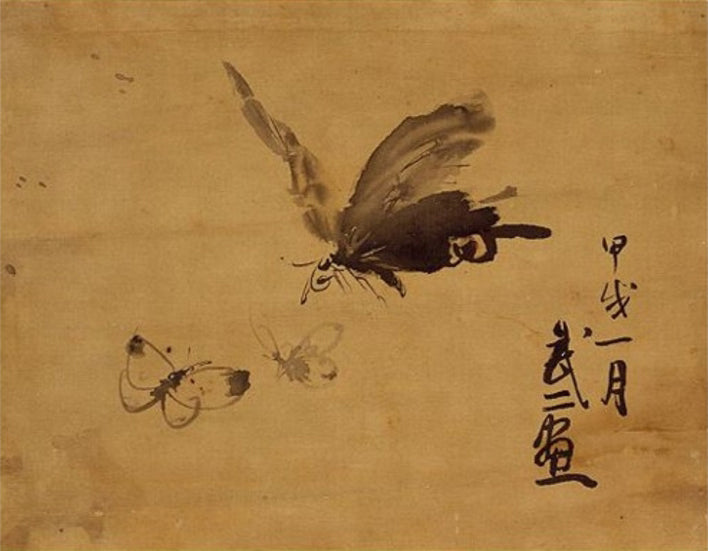Beschreibung
Fujishima Takeji, one of the leading exponents of the Nihonga movement, offers us, through his work Butterflies (1934), a profound meditation on the beauty of nature and its interrelation with Japanese aesthetics. This painting, which is exhibited at the Kagoshima City Museum of Art, is a paradigmatic example of how traditional Japanese technique merges with modern sensibilities of the 20th century.
The composition of “Butterflies” is rich and enveloping, notable for its masterful use of space and color. The work features a group of butterflies that appear to dance in a vibrant, life-filled environment. The butterflies, with their wings spread out in a variety of patterns and colors, are the undisputed protagonists of the painting. Fujishima makes a careful study of naturalism; the textures of the wings, the sheen, and the nuances of each are remarkably detailed, reflecting her appreciation and observation of nature. The asymmetrical arrangement of the butterflies suggests movement and lightness, creating a sense of dynamism that invites the viewer to lose themselves in the flow of life they represent.
The use of colour is another aspect that deserves attention. Fujishima employs a vibrant palette, where deep blues and luminous greens provide a serene background that contrasts with the warm colours of the butterflies. This choice not only highlights the beauty of the insects, but also evokes an atmosphere of calm and harmony. The interplay of colours, together with the fluidity of the forms, suggests a spiritual connection with nature, a recurring theme in Fujishima’s works. In addition, the use of the Nihonga technique, which integrates mineral pigments and meticulous care, adds a visual depth that invites careful and reflective observation.
Although “Butterflies” features no human characters, the presence of these winged creatures could be interpreted as a representation of the fragility and transience of life, concepts deeply rooted in Japanese philosophy. Butterflies, often symbols of transformation and renewal, can evoke reflections on the ephemeral beauty of existence and the changing nature of time.
It is interesting to consider the relevance of Fujishima Takeji within the context of Nihonga, a style that seeks to preserve and reinvent traditional Japanese art in a rapidly modernizing world. His work is a celebration of natural beauty, a fundamental aspect of Asian art that resonates even today. Fujishima’s ability to unite the traditional with the modern, as well as his dedication to the observation of nature, establish him as a key figure in the evolution of contemporary Japanese art.
In short, Fujishima Takeji's Butterflies is not just a visual representation of beauty, but an invitation to a deeper reflection on the relationship between humans and their environment. Through the use of color, composition, and symbolism, the work becomes a visual dialogue that transcends time and space, impacting viewers and reminding them of the importance of nature in their daily lives.
KUADROS ©, a famous painting on your wall.
Hand-made oil painting reproductions, with the quality of professional artists and the distinctive seal of KUADROS ©.
Painting reproduction service with satisfaction guarantee. If you are not completely satisfied with the replica of your painting, we will refund 100% of your money.

